
Employee resistance and lack of management support are the top reasons why change initiatives fail. Yet supporting employees during an organizational change reduces resistance. So does clear communication and adequate training.
This guide shows leaders how to decrease resistance to change.
Why Does Resistance To Change Management Arise?
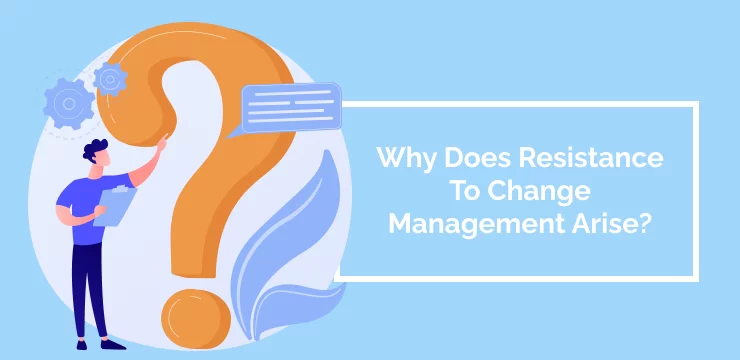
People who feel that they have a unique perspective or information that you didn’t consider enough in your plan are potential resisters. They probably disagree with your analysis of the problem you want to solve. So a wise leader would listen to their view and be open to changing their approach depending on their preferred learning style.
Sometimes the influential employees feel disrespected because you didn’t consult them when designing the change. These are likely veterans who have been with the organization for years. We recommend listening to such resisters respectfully and making them feel heard.
The fear of losing control also makes people resist change because the proposed change interferes with the way of doing things. So change leaders allow the people affected by the change to make some choices when designing and implementing the change initiative.
Resistance could also be about uncertainty and surprises when leaders don’t involve the employees in designing the changes and only announce the changes and a list of tasks. When the employees don’t have time to adjust to the new way, they automatically reject the changes. And not knowing what the change means for their future creates inevitable inertia – will they still have a job? Will they still be valuable? Who will the report to? To manage such resistance, leaders should be transparent about the impact of the change early on.
In some instances, too many different changes at once overwhelm employees. They may also feel rushed. So leaders would avoid introducing many unrelated changes at once. And instead, focus on the most significant changes. They may also adjust the project timelines to allow enough time for adjusting.
As with most IT-related changes, people may feel incompetent to execute the change successfully. Managers in other departments may feel that they can’t answer questions regarding the project, let alone oversee the change processes. And considering the different learning speeds, some employees may fear that they’ll struggle to learn the new system. So organizations must invest enough resources to provide the necessary training and education. And to motivate the employees to learn the new system, leaders would assure them that the change will upskill them to suit the current or future marketplace.
Finally, the changes might feel like more work. People hardly want to add more tasks to their routine. Plus, some have competing commitments or wish to maintain the status quo. So leaders should give the employees enough time for training and adjusting. Change management begins months before the changes go live. Leaders should also recognize good work through bonuses, recognition, and other incentives.
How To Spot Resistance To Change

Emotions heightened during change, so people respond with behaviors that show their struggle to adapt. When you have feedback mechanisms (e.g., surveys, audits) in place during a change, it’s easier to identify resistance. Here are the common signs of resistance:
- Employees avoiding new assignments
- They start getting to work late, leaving early, and missing some days
- Reduced productivity – e.g., missed deadlines, absenteeism
- Taking long to adopt the changes
- Complaints
- Lacking interest and morale
- Increased job transfer requests
- Delays in making decisions
- Sabotage
What Prolonged Resistance To Change Means For Your Business
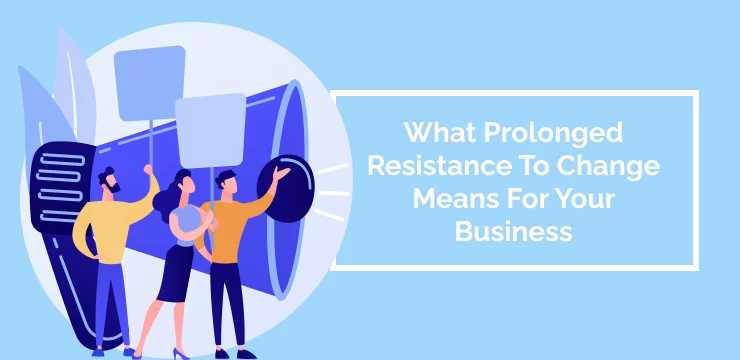
Extended change resistance delays a project execution which hinders benefit realization. That’s why most change initiatives fail to achieve their goals. Such delayed projects kill employee morale which reduces their productivity.
When employees sabotage change initiatives, the business risks going obsolete or losing to competitors. The organization misses opportunities to improve efficiency and lower costs with technology or better business models.
Resistance to change also reduces job satisfaction because of the stress involved when adjusting to the change. It lowers the quality of work and performance. And some valued employees could leave.
However, resistance to change is not always negative. Extended resistance is the feedback that organizations should dig into. That’s why organizations gather feedback throughout a change management initiative to understand the root causes and address them. And while at it, leaders should be open to changing their approach.
What Is The Unified Value Proposition?

The Unified Value Proposition is a Prosci framework for defining and positioning change management. It provides a direction for connecting the technical and people sides of change. The technical side includes software, hardware, processes, requirements, policies, reporting structure, and other technical aspects of a change. In contrast, the people side includes the efforts to help people adopt the new system.
It starts with the Reason for the change, then progresses through three states of an organization during change – Current State, Transition State, and Future State. And when the People and Technical side work together, it ends in Success.
How To Address Resistance To Change
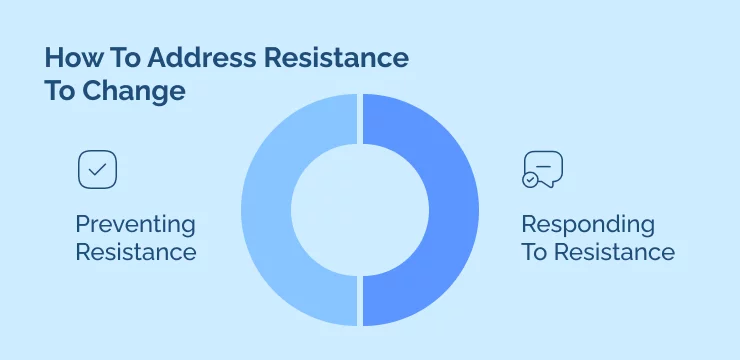
Managing resistance involves identifying potential resistance areas and designing mitigation plans before the change begins. If resistance arises after go-live, leaders should dig deep into the root causes of resistance and address them.
Preventing Resistance
Ongoing two-way communication and education are the top ways to prevent resistance to change. Clear communication helps people understand the reason for the change, and gathering feedback allows change teams to address the people’s fears. Education dispels doubts and provides correct information. It could be in the form of presentations, one-on-one conversations, memos, and reports.
As long as the change initiative is incomplete, education does not stop. For example, a division manager who wanted to change the division’s structure prepared an hour-long audiovisual presentation explaining the need and reasons for the change. He presented the exposition more than twelve times to managers for four months.
Involve potential resisters in designing and implementing the change initiative. When the resisters participate in the change, the change initiator will learn about their concerns, deliberate over them, and use their advice to improve the initiative.
Participation could go as far as how one company president asked eight managers to recommend changes to the company’s reward system. And after they brought the recommendations, the president accepted them and tasked the managers to help the personnel director implement the changes.
Practical training and support also prevent resistance. Create training content in different formats that suit your employees best. And when rolling out new applications, consider using a digital adoption platform to provide in-app, on-demand guidance. Support could mean listening to the people’s concerns (having feedback mechanisms in place), empathizing with them (e.g., giving individuals time off after strenuous periods), or even counseling them.
For example, the management in one company that had frequent changes hired four full-time counselors to talk with burn-out and stressed-out people. The management also selected four-week mini sabbaticals and spent hefty resources on training programs.
Examples source: HBR – Choosing Strategies for Change
Responding To Resistance
First, understand that resistance to change is feedback. It’s a resource. Viewing resistance as feedback, you can use it to refine the change management process.
For example, an IT executive prepared a hospital for change by educating the executives. She expected them to educate their teams and get employees on board. However, the executives feared the changes were bad news, so they stalled. And leaders who were not IT-competent felt incapable of addressing questions regarding the changes, so they stalled too. Another team (insurance) felt annoyed that the new system would make historical files inaccessible. In the end, the employees had no information – only rumors about the change.
Unsurprisingly, the IT executive had to postpone the changes and organize meetings to communicate them. But she understood the lesson here: she needed to explain to the entire hospital the purpose of the change.
Consider another COO who wanted to consolidate product design and capital planning engineers to improve collaboration and efficiency. But when he announced the plan, the capital planning engineers manager voiced his objections to the change at every turn of the meeting. Though the COO didn’t allow the manager to speak out about his ambiguous complaints, he later invited the manager for a private session.
After some probing, he found out why the manager opposed the change. They were reasonable complaints, so the COO asked for alternative ideas. Instead of consolidating the two teams, the manager proposed having bi-weekly consolidation meetings of the engineering teams. The company adopted the manager’s alternative idea because it met the company’s goals better than the COO’s plan.
Resistance to change could be about hearing your employees’ concerns. If getting pushback, consider collecting all ideas in your change meetings. Like how a phone center leader gathered ideas from her staff who opposed her cross-training initiative. She collected everyone’s thoughts which she grouped into either her worry list or idea list. She filtered out the wild ideas and took the list to the rest of the executive team. After collecting the execs’ input, she had a third list – the executive action list.
She carried the three lists to the follow-up change meetings. And to her surprise, the staff took up a proposal to train one another. And since it was their idea, they also developed a way to integrate it into the project plan. The leader also embraced the staff’s concerns about whether they’d get along and organized events to build stronger relationships.
Finally, sometimes resistance to change is about past failures. If that’s so, leaders need to acknowledge the past and take steps to bury the past. It could mean a public apology. Like when the head of a vehicle service organization discovered that his predecessor had lied to the staff that they’d get pay raises and promotions after adopting a new system. So the head offered a heartfelt public apology and even apologized to each worker individually. Then he met with HR and VP directors to organize the raises and promotions that the organization could accommodate.
Examples source: HBR – Decoding Resistance to Change
When speaking with resistors, have the following in mind:
- Create time for unhurried one-on-one conversations
- Spend the most time (80%) listening
- Stay open to changing your approach
- Have more than two conversations with each resister – listen in the first conversation, then spend two days reflecting, and explain your decision in the second conversation
The Three-Step Process To Resistance Management
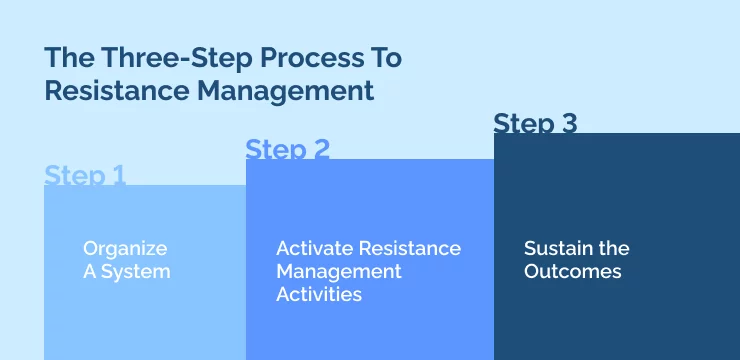
Step One: Organize A System
Start resistance management when creating your change management strategy deliverable. Here, identify potential areas of resistance and design the mitigation strategies. The strategies depend on the change’s nature, people, roles, organizational culture, and resources.
Consider the following strategies for your system:
- Listening and understanding objections
- Offering incentives
- Removing barriers to change
- Showing the change’s benefits in a clear and practical way
- Providing clear choices and consequences
Step Two: Activate Resistance Management Activities
Organizations implement resistance management strategies and actions as they execute the change management plan. So everyone should know their role in change management. Primarily, organizations begin change management processes months before the change goes live. If you wish to extend the resistance management efforts, you may have a different resistance management plan.
Step Three: Sustain the Outcomes
Track and review the progress of resistance management activities and other aspects of the change management plan. Then document lessons for future reference and improve as needed.
How To Incorporate Resistance Management Throughout The Project Lifecycle
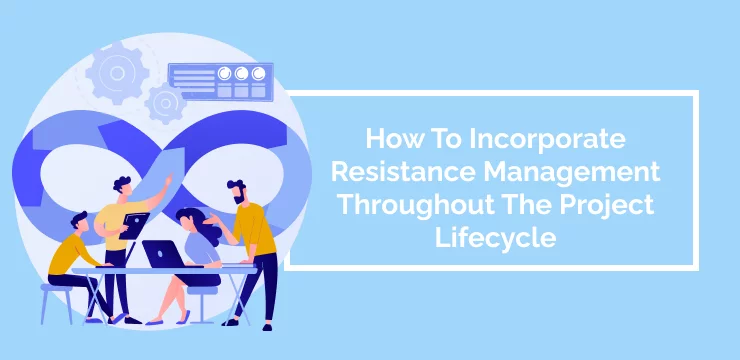
Project teams use different mechanisms to identify resistance throughout the project. For example, gathering employee feedback throughout the project, documenting and monitoring any issues the project team identifies, and conducting compliance audits.
You also need the right managers to manage resistance before and after the organizational changes go live. These are senior leaders, frontline supervisors, and middle managers. Supervisors and managers are the key because they’re the closest to employees. They’ll identify resistance and manage it while supporting employees through the change process. In addition, since employees look to senior leaders, they must demonstrate their commitment to the change throughout the project.
Final Thoughts: Overcoming Resistance to Change
Missed meetings, missed deadlines, and employees avoiding responsibilities are some of the signs of resistance to change. They’re often unconscious behaviors arising from things that might scare employees about change, such as feeling disrespected, incompetent, or uncertain. Instead of fighting resistance, leaders should treat it as feedback. That’s effective change management.
To prevent resistance, have clear, two-way communication, provide adequate training, and involve the potential resisters in designing and implementing the change. After resistance arises, dig into the root causes and address them. Listening to people is the first step to overcoming resistance.
Organizations incorporate resistance management into a project’s lifecycle by having feedback mechanisms, for example, using surveys to gather employee feedback.
WalkMe Team
WalkMe spearheaded the Digital Adoption Platform (DAP) for associations to use the maximum capacity of their advanced resources. Utilizing man-made consciousness, AI, and context-oriented direction, WalkMe adds a powerful UI layer to raise the computerized proficiency, everything being equal.



